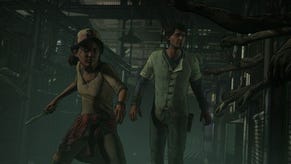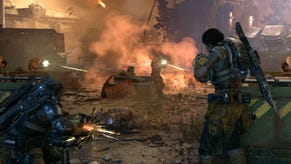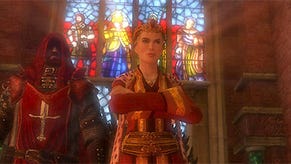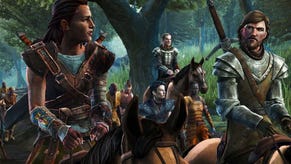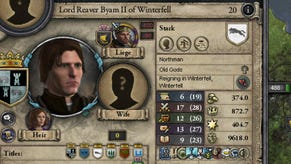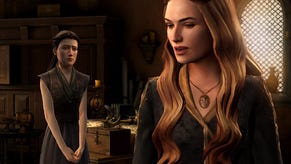A Preview Of A Game Of A Game Of Thrones
Damn, it feels good to be a vassal of the Lannisters
An important point, I hope: Game Of Thrones the game existed and was in active development before Game Of Thrones the show did the whole sexy Tolkien thing on our TV screens. While this is of course no guarantee that it is more Stark than Frey, it does mean we don’t need to worry that it’s been rushed to market to capitalise on Dinklagemania. The TV show came about early enough that developers Cyanide were able to redesign their takes on characters including Cersei (she bones her brother!), Lord Mormont (he hates his son but he’s a good sort otherwise!) and Varys (he's got no goolies!) to use their respective actors’ likeness and voices, but we’re told that, for the most part, the game was designed closely around the books.
“When we showed George Martin The Wall,” says lead designer Sylvain Sechi of introducing the books’ author to the giant, miles-long icy structure/metaphor that protects the land of Westeros from the wildlings (and worse) that lurk up north, “he says ‘that's a very, very big wall.” Upon their explaining to him that they’d made it to scale according to his description, he replied that “I wrote it too big!”
Much is made of Martin’s consultation and apparent approval, though it is admitted that he’s not a gamer so may not be an entirely reliable witness. (I’d also argue that the degree to which he mucks his readers around in the most recent two books perhaps doesn’t make him an entirely trustworthy judge of what makes a strong narrative, but that’s probably just my bitterness speaking. )
He hasn’t written GoT:TG’s story or dialogue, but he has advised on it and even given information on what’s due to happen later in his books to ensure none of the game’s new characters wind up in the wrong place at the wrong time and none of his characters say something that contradicts their future behaviour. And so it is that this is a side-narrative that sits alongside the first book/season, occasionally interweaving with Martin’s characters and tale but for the most part documenting a brand new adventure for two brand new characters.
Those are Mors Westford, Night Watchman – a ramshackle but tough military division made of up former prisoners, fallen nobles, disowned bastard sons and good souls with guilty consciences, tasked with guarding The Wall in the name of whosoever happens to hold the Iron Throne.
Mors has been on the Wall for 15 years when the game begins, so he’s old, he’s grizzled, he’s not too much of a looker and he’s initially clad in the dark hood of a Ranger. By his side is faithful and most certainly not cute dog, which he will later be able to order around and even control to some degree if the player pours their upgrade points into the Skinchanger tree.
On the other side of Westeros is Mors’ sometime friend Alester Sarwyck. He’s returning to his well-to-do home in RIverspring after 15 years away to attend the funeral of his father. The Sarwycks are a vassal of the Lannisters, the family of Westeros’ duplicitous, power-hungry brother-lovin’ (and also brother-hatin’, depending on which one you mean) queen Cersei. At this point, however, the Lannisters’ grand schemes and betrayals have yet to come to pass. No-one yet knows they’re playing the game of thrones. The iffy politics of Westeros is all present and correct however, with Alester’s prime motivation for having left Riverspring being to escape an arranged marriage to his own sister. Ew.
During his absence, he’s pledged his faith to R’hllor, Lord of Light - an act of borderline illegal blasphemy but one that has granted him some mysterious fire powers. This is low rather than high fantasy, and Red Priests’ abilities are often a matter of suggestion and trickery rather than overt magic in the books (at least at first), but there’s definitely mysticism at play here alongside more outwardly explicable stuff like using a flammable oil (Wildfire, geeks) to temporarily turn a standard sword into a fiery sword.
“The Red Priest was difficult to do because Melissandre [Stannis’ minion/puppeteer, and the perhaps the most openly magical character in the books] was not typical of their powers,” admit Cyanide. So George Martin had to put them “on track with some spoilers about what these guys can really do.”
So that’s the setup. The story is split into chapters which will largely alternate between the two, though eventually they meet up and join efforts. Most of the time, whoever you’re controlling will have some sort of companion character to help drive story and pitch in during fights. The game apparently contains around 270000 words of dialogue (“as much as you get in the first book”) and will take around 25 hours to complete if you rush through it, more like 35-40 if you explore everything.
It is a linear game, a fixed story with only a handful of (apparently quite sizeable) side missions. At one point it was going to be something of a Skyrim-style sandbox, but the decision was apparently made that “we really want an impactful story” as that’s more in keeping with the source material. I can’t attest to which is the right decision without playing hours of it. I’d certainly love to play something that was organically pushing and reshaping the boundaries of Westeros’ ruling families domains, a sort of hybrid of Total War and STALKER: Clear Sky, but I totally appreciate that going sandbox is so often a recipe for random quantity over focused quality unless you have a monstrous budget to call upon.
The other major foundation of Martin’s books and the resultant show (sexy funtimes aside) is, of course, wanton violence. GOT:TG seemed to have all the hallmarks of a hacky-slashy meathead marathon, so I was a little surprised to discover that it’s actually built around tactical pause-time combat in the vein of Knights of the Old Republic or Dragon Age. To an even greater degree than those are, I think. You pause, up pops some ability menus with the fight going on in super-super-slow motion behind it, you chain together up to 3 attacks, moves, spells, potions and whatnot, including switching foes mid-fight if you wish, you resume and then it all plays out in real-time.
It’s also surprisingly statty. In a somewhat MMOish way perhaps, with messages like 'bleeding', ‘miss’ and precise HP loss popping, but in many cases this is there as a prompt to employ particular abilities. Mors, for instance, has special attacks which will cause double damage to bleeding enemies. Hammering your way through apparently won’t get you very far, so in theory it’s a game of thrones, observation, tactical thinking and even memorisation.
On top of that, your character build will be on that in theory reflects your preferred playstyle rather than a Skyrimian jack of all trades. Of course I can’t speak for how fluid and comprehensible this is going to be in practice, but there does seem to be a vested interest in making this a cRPG rather than Mass Effect with swords and incest.
That said, moral and conversation options will apparently come back to bite you on the arse. Early choices can have after-effect seven chapters later apparently, while the broader option of using cunning and caution rather than outright brutality tends to mean a longer-winded but less difficult time of things. For instance, charge and area and all the guards will be alerted and rush you, or use Mors’ Skinchanger ability to have his dog sneak about, occasionally using an assassination bite attack to take loners out unseen.
It aims also to specialise in the grey areas of ethics, in nastiness and in grime. One quest resolution involved saving or killing a child. A visit to a local brothel presented, um, homely staff rather than the glamorous denizens of the TV show’s cathouses. There’s no romance. It’s grubby. I really, really need to play it to form any fixed opinions, but I’m certainly leaning towards it being a faithful passion-project, not the cold cash-in we feared after the confused, sodden strategy of Game of Thrones: Genesis.
I didn't see any dragons, nudity, red comets, Dinklages or shocking important character deaths, sorry.
Game of Thrones is out in June.








